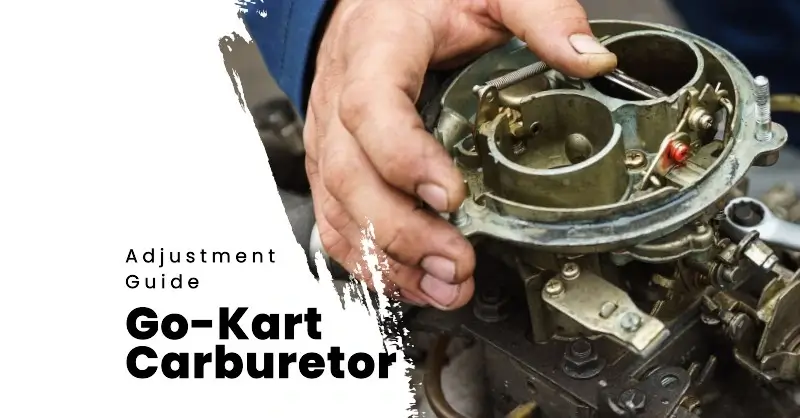A carburetor is crucial to your go-kart, ensuring your engine receives the optimal air-fuel mixture. Running on a lean fuel mixture can cause misfires and loss of low-end torque. On the other hand, running on a rich fuel mixture can lead to engine knocking and poor fuel economy. This guide will cover how to adjust the carburetor on your go-kart.
| Key Takeaways |
|---|
| Adjust the air-fuel mixture using the pilot screw to achieve optimal engine performance. |
| Set the ideal idle speed by adjusting the idle screw, ensuring smooth engine operation. |
| Regularly clean and inspect your carburetor for wear or damage to maintain efficiency. |
| Use quality fuel and replace air filters as recommended to prevent carburetor issues. |
Related Article: Best Go-Kart Carburetors
Carburetor Adjustments for Your Go-Kart
There are two screws you can adjust to ensure your engine gets the right fuel mixture and idle speed:
1. Air-Fuel Adjustment (Pilot Screw)
The first adjustment is the air-fuel adjustment, ensuring your go-kart engine gets the optimal air-fuel mixture. To do this, locate the pilot screw.
Where to Find the Pilot Screw
The pilot screw is typically located on the air intake side of the carburetor, attached to the intake manifold and the air filter. In some carburetors, the pilot screw is on the fuel inlet instead. Generally, these screws are referred to as pilot screws.
How to Adjust the Air-Fuel Ratio
By adjusting the inflow of air or fuel, you can ensure that your engine receives the optimal air-fuel ratio. Follow these steps:
- Lightly fasten the screw: Turn the screw clockwise until it’s seated. Use a compatible screwdriver and stop when you feel light resistance.
- Return to factory setting: Turn the screw counterclockwise (loosen it) by 2 full turns. This is the factory setting and should typically be optimal for your go-kart.
- Finalize air-fuel adjustment: Turn on your engine and listen closely to it while taking your go-kart for a ride. Test it at different RPMs.
If you observe that the engine is bogging, the fuel mixture is too lean. Adjust the pilot screw to restrict the amount of air into the carburetor by tightening it slightly. If the mixture is too fuel-rich, loosen the pilot screw to let in more air.
2. Idle Adjustment (Idle Screw)
The second adjustment is the engine idle speed. An engine running at a low idle speed can lead to vibrations and cause the engine to shut off. If the idle speed is too high, you’ll burn more fuel.
Where to Find the Idle Screw
The idle screw is typically found on the neck (center) of the carburetor and increases or reduces air-fuel flow into the go-kart engine. Some idle screws look like air-fuel screw that requires a screwdriver, while others are finger screws that allow for easier adjustments.
How to Adjust the Idle Speed
The idle screw controls the amount of air and fuel that enters the engine. The more you let the carburetor pump in, the higher the engine’s idle speed. Conversely, the less air and fuel that enters the engine, the lower the idle speed.
Use a suitable screwdriver or your fingers to set the idle speed. Do this with the engine switched on and in neutral gear. Observe the engine’s behavior and sound while idling. If the idle speed is too low, turn the idle screw clockwise to allow more fuel and air to enter the engine. If the idle speed is too high, turn the idle screw counterclockwise to restrict fuel and air entry into the engine.
- Warm up the engine: Start your go-kart and let it run for a few minutes to reach its average operating temperature.
- Observe the engine idle: Listen to the engine while idling and observe its behavior. The engine may stall or run roughly if the idle is too low. If the idle is too high, the engine will sound like it’s revving.
- Adjust the idle speed: Turn the idle screw clockwise to increase the idle speed or counterclockwise to decrease it. Make small adjustments and observe how the engine reacts.
- Test drive: After adjusting the idle speed, take your go-kart for a test drive. Ensure it maintains a steady idle when you stop and there are no issues when accelerating or decelerating.
- Fine-tune: If necessary, make further adjustments to the idle screw to achieve optimal speed.
Remember that the ideal idle speed may vary depending on your specific go-kart model and engine type. It’s essential to refer to your go-kart’s user manual for the recommended idle speed settings.
Related Article: How to Fix a Go-Kart Carburetor Leaking Gas
Tips for Maintaining Your Go-Kart Carburetor
To keep your go-kart running smoothly and efficiently, follow these maintenance tips:
- Regular cleaning: Clean your carburetor regularly, especially if your go-kart is used in dusty or dirty environments. A clean carburetor will ensure proper air and fuel flow, improving performance and fuel efficiency.
- Inspect for wear and damage: Regularly check your carburetor for any signs of wear or damage. Replace worn or damaged parts as needed to maintain optimal performance.
- Use quality fuel: Always use high-quality fuel to prevent the buildup of deposits and dirt in your carburetor.
- Replace air filter: Replace your go-kart’s air filter as the manufacturer recommends. A clogged air filter can restrict airflow, causing poor engine performance.
Related Article: How to Clean a Go-Kart Carburetor
By following these tips, you can ensure optimal performance and fuel efficiency. Remember that every engine is different, and it’s essential to refer to your go-kart’s user manual for specific guidance on carburetor adjustments and maintenance.

Goran, an experienced go-kart racer, fuels GoKartLife.com with his passion and expertise. He offers valuable insights and tips for fellow enthusiasts, fostering the growth of the go-kart community. Join Goran at GoKartLife.com and immerse yourself in this exhilarating sport.

